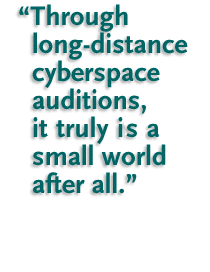 isney is making a new movie. In Berlin, auditions have just begun. The actors are trying out for the German voice-overs -- the film's English sound track will be dubbed with a German one. At the same time in Burbank, California, audio directors are monitoring the auditions just as final edits for the film are hitting Burbank's cutting-room floor.
isney is making a new movie. In Berlin, auditions have just begun. The actors are trying out for the German voice-overs -- the film's English sound track will be dubbed with a German one. At the same time in Burbank, California, audio directors are monitoring the auditions just as final edits for the film are hitting Burbank's cutting-room floor.The use of an ISDN line to transmit audio from Berlin to Burbank with no audible loss of sound quality is newsworthy in itself. But the larger benefit is the time saved, says Michael W. Jones, a Disney voice-casting executive.
"Without this Digital Interactive Audio Link [DIAL]," he says, "the Berlin office would bring in local talent, audition them, record their voices, and mail the tape to Burbank. Then we would listen to the tape and write down some comments, which we would fax back to Berlin. This process would be repeated over and over again until we had actors picked for all the voice parts." Multiply this process by the 29 languages in which Disney releases its films, and the amount of time saved because of DIAL becomes really obvious.
Now, in countries equipped with DIAL, auditions are transmitted live to Burbank, where voice-casting directors listen and make their selections for each role. "This helps us reach the Disney objective for a 'foreign-language' film that feels as if it were originally created in that language," says Michael.



